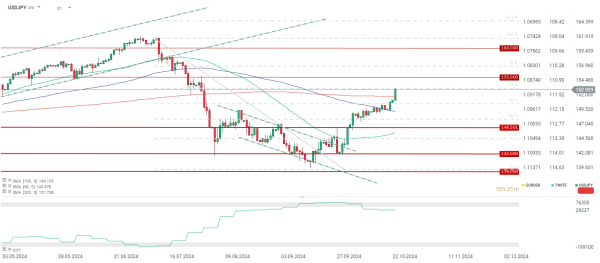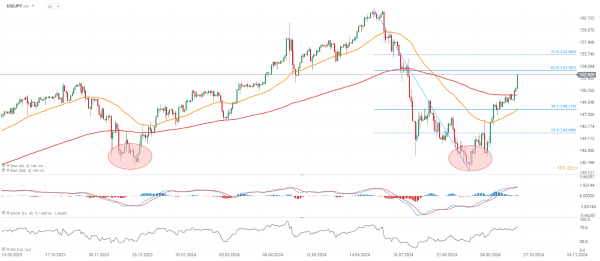📈USDJPY surges 1.3%
🚩Uncertainty ahead of the Japan elections, BoJ's stance, strong dollar and sluggish growth forecasts are weakening the Japanese yen
The yen is losing almost 1.3% today against the US dollar today, due to several factors.
- Japan's upcoming elections on October 27
- The Bank of Japan's decision on October 31
- Elections in the United States
- The Fed decision
- Weak economic forecasts from the IMF
Bad times for yen?
- Elections in Japan will be held this Sunday, and recent polls show that the current ruling coalition may not hold a majority. Markets don't like change, and there is a good chance that another government will have a different idea for the faltering economy.
- Immediately after the election, the Bank of Japan will make a decision. Communication from the BoJ has not hinted at an imminent interest rate hike recently. The next hike is not possible until March, when the market gives the move an 80% probability.
- The yen is also weakening due to the increasing likelihood of Trump winning the election. Popular betting portals give 60 to 64% probability for the former president to win. Trump has repeatedly spoken negatively about Japan's policy of maintaining a weak yen and has been eager to impose tariffs on Japanese products.
- The IMF is lowering the growth outlook for Japan this year to just 0.3% y/y from 0.7% y/y. In its decision, the IMF points out that the boom in tourism due to the cheap yen was only a one-time event, plus the auto sector is in a lot of trouble.
... And good times for US dollar
Part of the sell-off is also due to the strength of the U.S. dollar. Yields on 10-year Treasury bonds rose yesterday to 4.2%, a level not seen since July, providing evidence that the market does not see an aggressive cycle of Fed cuts as the base case scenario for the next few quarters.
- While the IMF lowered GDP growth forecasts for most developed economies, for the United States it raised its economic growth forecast for 2025. Currently, the market is pricing in a nearly 13% chance of no Fed rate cut, in November, but next year is in greater question,
- According to the 'dotplot' presented at the September meeting, we should see up to ca. 100 bps of rate cuts next year. With strong macro data from the US economy and the risk of rising oil prices, the market now sees such a scenario as less realistic; the labor market shows no 'alarming' signs of a slowdown, drawing any pressure from the Fed for an accelerated easing cycle.
USDJPY (D1 interval)
USDJPY is breaking through the 200-session average, having earlier bounced off the 100-session average. The pair is currently at its highest since July this year. We are also seeing a decline in long positions and an increase in short positions, indicating speculative capital's doubt about the yen's ability to remain strong. The pair is currently testing the abolition of 61.8 of the last downward wave. If this level is pierced, the next important target for the pair will be the 155 level. At present, only an interest rate hike preceded by a clear victory for the LDP party in Japan could turn the tide on the currency pair.


Source: xStation5